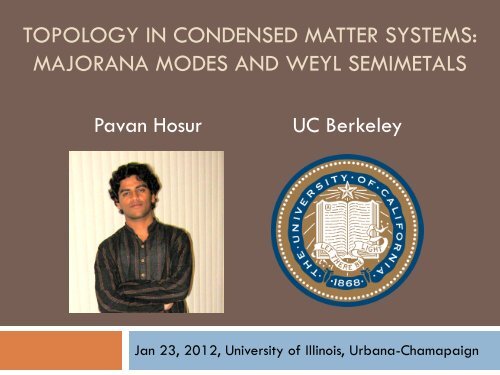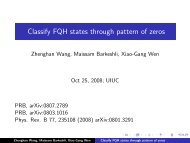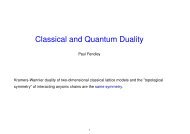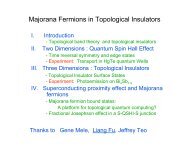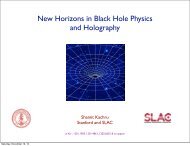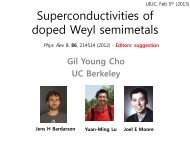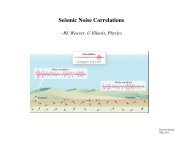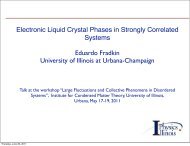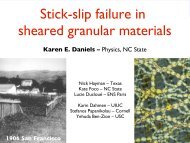Majorana modes and Weyl semimetals - Institute of Condensed ...
Majorana modes and Weyl semimetals - Institute of Condensed ...
Majorana modes and Weyl semimetals - Institute of Condensed ...
You also want an ePaper? Increase the reach of your titles
YUMPU automatically turns print PDFs into web optimized ePapers that Google loves.
TOPOLOGY IN CONDENSED MATTER SYSTEMS:<br />
MAJORANA MODES AND WEYL SEMIMETALS<br />
Pavan Hosur<br />
UC Berkeley<br />
Jan 23, 2012, University <strong>of</strong> Illinois, Urbana-Chamapaign
Acknowledgements<br />
Advisor:<br />
Ashvin Vishwanath<br />
UC Berkeley<br />
Collaborators:<br />
Pouyan Ghaemi Roger Mong Sid Parameswaran<br />
UC Berkeley → UIUC UC Berkeley UC Berkeley
Outline<br />
Introduction: General examples <strong>of</strong> topology in<br />
condensed matter<br />
Focus example 1: <strong>Majorana</strong> <strong>modes</strong> using<br />
topological insulators <strong>and</strong> superconductors<br />
Focus example 2: <strong>Weyl</strong> <strong>semimetals</strong> – introduction<br />
<strong>and</strong> transport
Outline<br />
Introduction: General examples <strong>of</strong> topology in<br />
condensed matter<br />
Focus example 1: <strong>Majorana</strong> <strong>modes</strong> using<br />
topological insulators <strong>and</strong> superconductors<br />
Focus example 2: <strong>Weyl</strong> <strong>semimetals</strong> – introduction<br />
<strong>and</strong> transport
Topology in real space<br />
Topological defects<br />
Domain walls – charge density<br />
wave, quantum magnets<br />
Vortices – type-II<br />
superconductors, superfluids<br />
Hedgehogs – quantum magnets,<br />
valence bond solids
Topology in momentum space<br />
Topological b<strong>and</strong> structures<br />
Integer quantum hall<br />
state (Chern insulator)<br />
Topological insulators<br />
Topological<br />
superconductors (e.g.<br />
He-3 B)<br />
Singularities in dispersion<br />
Fermi surface<br />
Line nodes (e.g.<br />
graphite)<br />
Point nodes (e.g.<br />
Graphene, <strong>Weyl</strong><br />
<strong>semimetals</strong>)
Combining real <strong>and</strong> momentum space<br />
topologies<br />
Fermionic Hopf skyrmion in topological insulatorsuperconductor<br />
system<br />
[Ran, PH, Vishwanath „11]<br />
Vortex in p+ip superconductor [Read-Green‟00]<br />
Vortex in superconductor on topological insulator<br />
surface [Fu-Kane‟08]<br />
Carry <strong>Majorana</strong> zero <strong>modes</strong>
Outline<br />
Introduction: General examples <strong>of</strong> topology in<br />
condensed matter<br />
Focus example 1: <strong>Majorana</strong> <strong>modes</strong> using<br />
topological insulators <strong>and</strong> superconductors<br />
Focus example 2: <strong>Weyl</strong> <strong>semimetals</strong> – introduction<br />
<strong>and</strong> transport
Crash-course on topological insulators:<br />
surface<br />
surface states<br />
Bulk insulators; surface states<br />
traversing bulk gap protected by<br />
time-reversal symmetry<br />
<br />
top.<br />
ins.<br />
vacuum<br />
Surface states “relativistic” at low<br />
energies<br />
p-Berry phase around<br />
the Fermi surface
Crash-course on topological insulators:<br />
Z 2 invariant 0<br />
0<br />
= -1 => topological insulator<br />
= 1 => trivial insulator<br />
Surface:<br />
0<br />
= (-1)<br />
number <strong>of</strong> Dirac nodes<br />
Inversion symmetric bulk:<br />
(000) (00p)<br />
Trivial insulator<br />
<br />
p-b<strong>and</strong><br />
s-b<strong>and</strong><br />
0<br />
<br />
<br />
k TRIM<br />
P occ<br />
(k)<br />
(000) (00p)<br />
Topological insulator<br />
TRIM = timereversal<br />
invariant<br />
momenta<br />
P = parity eigenvalue<br />
b<strong>and</strong> inversion
Crash-course on topological insulators:<br />
real materials<br />
Bi-Sb alloy<br />
[Fu‟07, Hsieh‟09]<br />
Bi 2 X 3 , X=Se,Te<br />
[Chen‟09, Hsieh‟09…]<br />
Tl-chalcogenides [Yan‟10,…]<br />
Half-heusler<br />
compounds [Xiao‟10,…]<br />
…<strong>and</strong> many more
<strong>Majorana</strong> fermions in superconductors<br />
<strong>Majorana</strong> fermion: particle that is its own antiparticle<br />
Bogoliubov-de Gennes Hamiltonian has inherent<br />
E → – E symmetry<br />
<strong>Majorana</strong> zero mode<br />
(Protected by<br />
“particle-hole” symmetry)
Systems with <strong>Majorana</strong> zero <strong>modes</strong><br />
Vortices in…<br />
p+ip superconductor<br />
[Read, Green '00]<br />
Superconductor-topological insulator interface<br />
[Fu, Kane<br />
'08]<br />
Semiconductor-superconductor heterostructures<br />
'10, Lutchyn et. al. '10, …]<br />
[Sau et. al.<br />
Possibly, 5/2 fractional quantum hall state [Read-Green'00,<br />
Moore-Read‟91]
<strong>Majorana</strong> mode at superconductortopological<br />
insulator interface<br />
Zero energy<br />
<strong>Majorana</strong> mode<br />
= h/2e<br />
s-wave superconductor<br />
Strong<br />
Topological<br />
Insulator<br />
Fu-Kane PRL 2008
<strong>Majorana</strong> mode in superconductingdoped<br />
topological insulator?<br />
= h/2e<br />
?<br />
Strong Metal<br />
Bulk Superconductor<br />
Topological by doping<br />
(parent insulator Insulator topological) STI<br />
Superconductivity in Bi 2 Te 3<br />
Zhang et al. PNAS „11<br />
Superconductivity in Bi 2 Se 3<br />
Hor et. al. PRL 2010<br />
Yes! But only if…<br />
PH, Ghaemi, Mong, Vishwanath, PRL‟11
Evolution as is raised…<br />
Fermi level<br />
in normal<br />
phase, which<br />
has a b<strong>and</strong><br />
inversion<br />
Upto what do <strong>Majorana</strong> <strong>modes</strong> survive?<br />
Evolution<br />
<strong>of</strong> vortex,<br />
surface<br />
<strong>Majorana</strong><br />
<strong>modes</strong><br />
<strong>Majorana</strong> mode<br />
present<br />
<strong>Majorana</strong> <strong>modes</strong><br />
from opposite<br />
surfaces annihilate<br />
<strong>Majorana</strong> mode<br />
absent<br />
PH, Ghaemi, Mong, Vishwanath, PRL‟11
Evolution as is raised…<br />
At what does the vortex have two bulk<br />
<strong>Majorana</strong> zero <strong>modes</strong>?<br />
Evolution<br />
<strong>of</strong> vortex<br />
spectrum<br />
<strong>Majorana</strong> mode<br />
present<br />
<br />
}<br />
2<br />
hv F<br />
<strong>Majorana</strong> <strong>modes</strong><br />
from opposite<br />
surfaces annihilate<br />
<strong>Majorana</strong> mode<br />
absent<br />
PH, Ghaemi, Mong, Vishwanath, PRL‟11
Towards main result: Analogy with<br />
spinless p+ip superconductor at fixed k z<br />
Superconducting doped<br />
topological insulator<br />
Spinless p+ip superconductor<br />
<br />
H BdG<br />
H - k<br />
<br />
* (r)<br />
Vortex:<br />
(r) <br />
<br />
- H k <br />
(r) 0<br />
(x iy)<br />
0<br />
(i kx<br />
- ky<br />
)<br />
<br />
Fermi surface has H<br />
<br />
k - =<br />
0. Expect a <strong>Majorana</strong> zero<br />
mode at p-Berry phase<br />
k ↔ r<br />
H px ip y<br />
<br />
(r) (i x<br />
- y<br />
) <br />
<br />
<br />
(i x<br />
y<br />
) -(r) <br />
Has <strong>Majorana</strong> zero mode<br />
at p-flux if ε(r 0 ) = 0 for<br />
some r 0<br />
PH, Ghaemi, Mong, Vishwanath, PRL‟11 Read-Green, PRB 2000
Main result: SU(2) Berry phase <strong>and</strong> c<br />
Time-reversal + inversion ⇒<br />
B<strong>and</strong>s doubly degenerate (Kramer‟s degeneracy)<br />
Berry connection non-Abelian, 2x2 matrix<br />
A ij<br />
(k) i u i<br />
(k) | k<br />
u j<br />
(k) ; i, j {1,2}<br />
At each k z , Berry phase factor around<br />
Fermi surface<br />
<br />
U B<br />
(k z<br />
) P exp i<br />
A ˆ (k) z ˆ SU(2)<br />
P = path-ordering;<br />
U(1)-part vanishes due to time-reversal+inversion;<br />
<br />
PH, Ghaemi, Mong, Vishwanath, PRL‟11
Main result: SU(2) Berry phase <strong>and</strong> c<br />
eigenvalues U B<br />
(k z<br />
) e i(k z ) , e -i(k z )<br />
<br />
BdG<br />
(k z<br />
) 0<br />
[(2n 1)p -(k z<br />
)]<br />
has zero mode if (k z ) = p<br />
0<br />
~ 2 /<br />
<br />
(k<br />
<br />
z<br />
) (-k z<br />
)<br />
⇒ 0, 4, 8…. zero <strong>modes</strong> at k z ≠ 0<br />
⇒ sufficient to focus on k z = 0, p<br />
<br />
PH, Ghaemi, Mong, Vishwanath, PRL‟11
C<strong>and</strong>idate Materials<br />
Among doped topological<br />
insulators:<br />
<br />
<br />
<br />
<br />
p-doped TlBiTe<br />
[Hein '70]<br />
2<br />
p-doped Bi 2<br />
Te 3<br />
under<br />
pressure<br />
[J. L. Zhang '11]<br />
n-doped Bi 2<br />
Te<br />
[Hor '10]<br />
3<br />
Cu-Bi 2<br />
Se<br />
[Hor '10, Wray'10]<br />
3<br />
near phase transition for c-<br />
axis vortex, but has<br />
<strong>Majorana</strong> <strong>modes</strong> for ab-axis<br />
vortex<br />
Among ordinary insulators<br />
<br />
Either PbTe or SnTe <strong>and</strong><br />
GeTe (PbTe has four b<strong>and</strong><br />
inversions relative to SnTe<br />
<strong>and</strong> GeTe)<br />
PH, Ghaemi, Mong, Vishwanath, PRL‟11
<strong>Majorana</strong> <strong>modes</strong> summary<br />
Surface <strong>Majorana</strong> zero <strong>modes</strong> present in vortex <strong>of</strong><br />
superconducting doped topological insulator below<br />
critical doping determined by Berry phase <strong>of</strong> normal<br />
state Fermi surface<br />
Several existing superconductors expected to carry<br />
vortex <strong>Majorana</strong> <strong>modes</strong>, possibly even nontopological<br />
insulator-based ones
Future questions<br />
What if parent insulator breaks inversion?<br />
What about other geometries such as domain<br />
walls?
Outline<br />
Introduction: General examples <strong>of</strong> topology in<br />
condensed matter<br />
Focus example 1: <strong>Majorana</strong> <strong>modes</strong> using<br />
topological insulators <strong>and</strong> superconductors<br />
Focus example 2: <strong>Weyl</strong> <strong>semimetals</strong> – introduction<br />
<strong>and</strong> transport
<strong>Weyl</strong> <strong>semimetals</strong><br />
3D materials with linear b<strong>and</strong>-touchings<br />
<strong>Weyl</strong> nodes “topological objects” in<br />
momentum space<br />
Dirac equation<br />
H ˆ x<br />
p x<br />
ˆ y<br />
p y<br />
ˆ z<br />
p z<br />
ˆ m<br />
<strong>Weyl</strong> equation<br />
H ˆ x<br />
p x<br />
ˆ y<br />
p y<br />
ˆ z<br />
p z<br />
<br />
<br />
<br />
<br />
<br />
<br />
1<br />
2<br />
3<br />
4<br />
<br />
<br />
<br />
<br />
<br />
<br />
<br />
<br />
<br />
<br />
1<br />
<br />
<br />
2<br />
No mass term possible<br />
in <strong>Weyl</strong> Hamiltonian!<br />
(unlike graphene)
Why study <strong>Weyl</strong> <strong>semimetals</strong>?<br />
Fermi arc surface states<br />
Chiral Anomaly<br />
Wan et. al. PRB 2011 Nielsen-Ninomiya PLB 1983<br />
Surface states <strong>of</strong> 4D<br />
Chern insulator<br />
Zhang-Hu Science 2001<br />
Real material c<strong>and</strong>idates:<br />
• Pyrochlore<br />
iridates<br />
• TI-FM multilayer<br />
• HgCr 2 Se 4<br />
Wan PRB‟11, Burkov PRL‟11, Fang PRL‟11
Transport in <strong>Weyl</strong> <strong>semimetals</strong><br />
e2<br />
<br />
h L -1<br />
With Coulomb interactions<br />
w
Coulomb transport: mechanism<br />
Generic Fermi surface<br />
j 0, k tot<br />
0<br />
Dirac dispersion at neutrality point<br />
j 0, k tot<br />
0<br />
<br />
<br />
No relaxation to k tot = 0 state<br />
without disorder<br />
=> No current!<br />
Interactions, even though they<br />
conserve momentum, sufficient to<br />
relax current
Coulomb transport: calculation<br />
Quantum Boltzmann analysis<br />
j(t) ev F<br />
QBE:<br />
<br />
<br />
ˆ k k<br />
f (k,t) E(t)<br />
( t<br />
eE k<br />
) f (k,t) wf (k,t) w = scattering rate; use<br />
Fermi‟s golden rule<br />
<br />
Fritz et. al., PRB 2008
Coulomb transport: calculation<br />
Quantum Boltzmann analysis contd.<br />
Rewrite integral equation as variational problem.<br />
V Coulomb<br />
(q) ~ 1 q 2<br />
=> small-q processes dominate<br />
Leading-log approximation:<br />
<br />
0<br />
dq<br />
q<br />
T<br />
dq<br />
ln -1<br />
T<br />
q<br />
, q = 0 elsewhere<br />
Variational ansatz eigenfunction <strong>of</strong> leading-log term.<br />
<br />
PH, Parameswaran, Vishwanath, arXiv:1109.6330
Coulomb transport: results<br />
<br />
N e2<br />
h<br />
DC limit interpretation<br />
<br />
<br />
e 2 D dn<br />
d<br />
D v F2<br />
,<br />
dc<br />
~ e2 1<br />
2<br />
h T<br />
1.8 k B<br />
T <br />
-i6.6 hw N 2 -1 <br />
k B T T<br />
ln T hv F<br />
(T) <br />
…thermally excited electron-hole plasma<br />
h -1 ~ N 2 T,<br />
T<br />
v F<br />
(T)<br />
<br />
dn<br />
d T 2<br />
3<br />
v F<br />
Use renormalized v F <strong>and</strong> ;<br />
e un-renormalized due to<br />
gauge invariance<br />
PH, Parameswaran, Vishwanath, arXiv:1109.6330
Coulomb transport <strong>and</strong> experiments<br />
1. Polycrystalline Y 2 Ir 2 O 7<br />
<br />
dc<br />
e2 1.8 k B<br />
T <br />
h 2 -1 <br />
T<br />
ln T hv F<br />
(T) <br />
Yanagishima-Maeno JPSJ 2001<br />
PH, Parameswaran, Vishwanath, arXiv:1109.6330<br />
Fit to theory – Coulomb<br />
interactions-driven resistivity
Coulomb transport <strong>and</strong> experiments<br />
2. Single crystal Eu 2 Ir 2 O 7<br />
<br />
dc<br />
e2 1.8 k B<br />
T <br />
h 2 -1 <br />
T<br />
ln T hv F<br />
(T) <br />
Low pressure curves<br />
show agreement with<br />
theory<br />
Tafti et.al. arXiv:1107.2544
Transport with disorder<br />
Born-approximation for self-energy<br />
Kubo formula for conductivity<br />
dc<br />
N e2<br />
h<br />
N e2<br />
12h w<br />
NT 2<br />
<br />
Order <strong>of</strong> limits w 0 <strong>and</strong> T 0 crucial!<br />
PH, Parameswaran, Vishwanath, arXiv:1109.6330
<strong>Weyl</strong> <strong>semimetals</strong> transport summary<br />
With interactions<br />
Quantum Boltzmann<br />
equation solved within<br />
leading-log approx.<br />
dc ~ T resembles<br />
experimental data<br />
With disorder (strength<br />
)<br />
Different behavior for<br />
w > T<br />
w > T: ~ |w|<br />
PH, Parameswaran, Vishwanath, arXiv:1109.6330
Future research<br />
Quantum oscillations due to Fermi arcs (in progress)<br />
Signatures <strong>of</strong> chiral anomaly<br />
<strong>Weyl</strong> <strong>semimetals</strong> <strong>and</strong> superconductivity<br />
Materials challenge – better cleavable materials<br />
…<strong>and</strong> more
Other projects<br />
Bosons in Kagome optical lattice<br />
Jo, Guzman Thomas, PH, Vishwanath, Stamper-Kurn<br />
arXiv: 1109.1591<br />
Photocurrent on topological insulator surface<br />
PH, PRB 83, 035309 (2011)<br />
Fermionic Hopf skyrmion in topological insulatorsuperconductor<br />
Ran, PH, Vishwanath, PRB 84, 184501 (2011)<br />
3D Topological phases <strong>and</strong> topological<br />
defects form the Dirac limit<br />
PH, Ryu, Vishwanath, PRB 81, 045120 (2010)
Thank you<br />
References<br />
1. <strong>Majorana</strong> <strong>modes</strong> at the ends <strong>of</strong> superconductor vortices<br />
in doped topological insulators<br />
PH, Ghaemi, Mong, Vishwanath, PRL 107, 097001<br />
(2011)<br />
Viewpoint by Taylor Hughes: <strong>Majorana</strong> fermions inch<br />
closer to reality, Physics 4, 67 (2011)<br />
2. Transport in <strong>Weyl</strong> <strong>semimetals</strong><br />
PH, Parameswaran, Vishwanath, arXiv: 1109.6330 (To<br />
appear in PRL)
Bulk-surface b<strong>and</strong> intersection <strong>and</strong> c<br />
<br />
Minimal model:<br />
H v D<br />
z<br />
k x<br />
m(k)<br />
Surface <strong>and</strong> bulk b<strong>and</strong>s intersect at<br />
E = v D k<br />
<strong>and</strong> <strong>Majorana</strong> <strong>modes</strong> can “leak in”<br />
At E bulk = v D<br />
k, m(k) = 0<br />
At m(k) = 0, Berry phase = p per<br />
k z =0 Fermi surface)
Crash-course on topological insulators:<br />
0 with inversion symmetry<br />
(000) (00p)<br />
p-b<strong>and</strong><br />
s-b<strong>and</strong><br />
<br />
0<br />
P(000)P(00p) (1)(1) 1<br />
...trivial insulator<br />
(000) (00p)<br />
p-b<strong>and</strong><br />
b<strong>and</strong> inversion<br />
s-b<strong>and</strong><br />
<br />
0<br />
P(000)P(00p) (-1)(1) -1<br />
...topological insulator<br />
(Assuming no b<strong>and</strong> inversions at other TRIMs)
Another perspective: Topological phase<br />
transition inside a topological defect<br />
<br />
<br />
Vortex = 1D system in class D (BdG with no timereversal<br />
or spin-rotation symmetry)<br />
Z 2 invariant signals presence/absence <strong>of</strong> end<br />
<strong>Majorana</strong> <strong>modes</strong> [Kitaev‟01]<br />
Evolution<br />
<strong>of</strong> vortex,<br />
surface<br />
<strong>Majorana</strong><br />
<strong>modes</strong><br />
Evolution<br />
<strong>of</strong> vortex<br />
dispersion<br />
PH, Ghaemi, Mong, Vishwanath, PRL‟11


